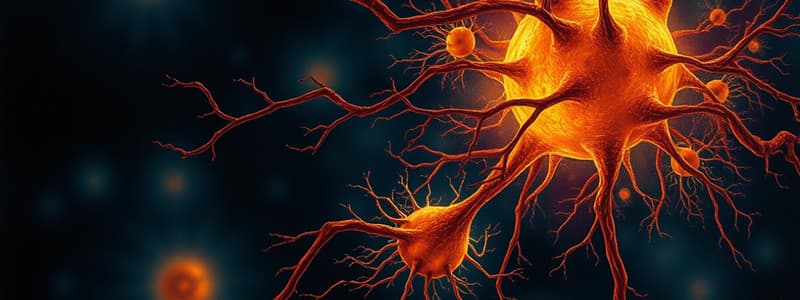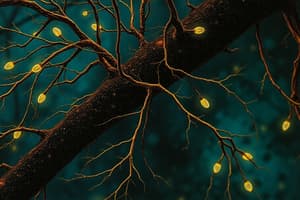Podcast
Questions and Answers
What is the primary role of satellite cells in the peripheral nervous system?
What is the primary role of satellite cells in the peripheral nervous system?
- To facilitate neurotransmission at synapses
- To provide insulation to axons in the peripheral nerves
- To act as immune responders against pathogens in the nervous system
- To wrap around nerve cell bodies and regulate the microenvironment (correct)
Which of the following structures do satellite cells primarily associate with?
Which of the following structures do satellite cells primarily associate with?
- Cerebral cortex and spinal column
- Cerebellum and thalamus
- Hippocampus and amygdala
- Dorsal root ganglia and parasympathetic ganglia (correct)
Which neuroglial cells are mentioned as having a structural function in the context provided?
Which neuroglial cells are mentioned as having a structural function in the context provided?
- Astrocytes
- Oligodendrocytes
- Satellite cells (correct)
- Microglia
What aspect of neuroglial cells requires further investigation according to the content?
What aspect of neuroglial cells requires further investigation according to the content?
What type of aphasia is characterized by issues in both receptive and expressive language?
What type of aphasia is characterized by issues in both receptive and expressive language?
Which type of neuroglial cell is associated with the peripheral nervous system?
Which type of neuroglial cell is associated with the peripheral nervous system?
What is the primary function of astrocytes in the central nervous system?
What is the primary function of astrocytes in the central nervous system?
Which neuroglial cell type is the least numerous but plays a critical role in immune surveillance in the brain?
Which neuroglial cell type is the least numerous but plays a critical role in immune surveillance in the brain?
Which of the following cells line the cavities of the brain and produce cerebrospinal fluid?
Which of the following cells line the cavities of the brain and produce cerebrospinal fluid?
Which classification of neuroglial cells is formed from a Greek term meaning 'star'?
Which classification of neuroglial cells is formed from a Greek term meaning 'star'?
What is a key feature distinguishing oligodendrocytes from Schwann cells?
What is a key feature distinguishing oligodendrocytes from Schwann cells?
Which type of neuroglial cell has processes that extend in all directions and are known for their versatility?
Which type of neuroglial cell has processes that extend in all directions and are known for their versatility?
Which neuroglial cell type is primarily associated with the support of neurons and the coverage of capillaries?
Which neuroglial cell type is primarily associated with the support of neurons and the coverage of capillaries?
What is the main function of tanycytes?
What is the main function of tanycytes?
Which characteristic is unique to choroidal epithelial cells?
Which characteristic is unique to choroidal epithelial cells?
How do Schwann cells relate to peripheral axons?
How do Schwann cells relate to peripheral axons?
What physical structure aids in the tight junctions of choroidal epithelial cells?
What physical structure aids in the tight junctions of choroidal epithelial cells?
What is the role of the lipid composition in Schwann cell membranes?
What is the role of the lipid composition in Schwann cell membranes?
What is a potential outcome of damage to tanycytes?
What is a potential outcome of damage to tanycytes?
What distinguishes the myelination performed by Schwann cells from that of oligodendrocytes?
What distinguishes the myelination performed by Schwann cells from that of oligodendrocytes?
What mechanism allows choroidal epithelial cells to maintain the integrity of cerebrospinal fluid?
What mechanism allows choroidal epithelial cells to maintain the integrity of cerebrospinal fluid?
What is the primary function of association fibers within the cerebral hemisphere?
What is the primary function of association fibers within the cerebral hemisphere?
What are the two main types of association fibers?
What are the two main types of association fibers?
What characterizes short association fibers?
What characterizes short association fibers?
Which area is typically affected by damage to the left cerebral hemisphere?
Which area is typically affected by damage to the left cerebral hemisphere?
Which of the following best describes the uncinated fasciculus?
Which of the following best describes the uncinated fasciculus?
What is a common cause of deficits in language production and comprehension?
What is a common cause of deficits in language production and comprehension?
Which hemisphere preserves the ability to express through facial expression, gestures, and intonation despite language deficits?
Which hemisphere preserves the ability to express through facial expression, gestures, and intonation despite language deficits?
How do long association fibers differ from short association fibers in terms of structure?
How do long association fibers differ from short association fibers in terms of structure?
What is the primary role of neuroglial cells in the nervous system?
What is the primary role of neuroglial cells in the nervous system?
Which type of primary brain tumor is classified as the most malignant?
Which type of primary brain tumor is classified as the most malignant?
Which tissue type provides a framework for nerve cells and fibers?
Which tissue type provides a framework for nerve cells and fibers?
What is a key function of neuroglial cells during repetitive firing of a neuron?
What is a key function of neuroglial cells during repetitive firing of a neuron?
In what circumstance do astrocytes proliferate to fill spaces previously occupied by neurons?
In what circumstance do astrocytes proliferate to fill spaces previously occupied by neurons?
Which of the following statements about neuroglial cells is not true?
Which of the following statements about neuroglial cells is not true?
What role do neuroglial cells serve regarding the blood-brain barrier?
What role do neuroglial cells serve regarding the blood-brain barrier?
What does gliosis refer to in the context of neuroglial cells?
What does gliosis refer to in the context of neuroglial cells?
Flashcards are hidden until you start studying
Study Notes
Neuroglial Cells
- Neuroglial cells provide metabolic and mechanical support for neurons, playing a crucial role in maintaining homeostasis.
- They undergo mitosis and are about ten times more abundant than neurons, comprising roughly half the brain's volume.
- Common types include astrocytes, microglial cells, ependymal cells, oligodendrocytes, Schwann cells, and satellite cells.
Classifications of Neuroglial Cells
-
Central Nervous System (CNS)
- Astrocytes: Largest and most versatile, with branched processes for structural support, nutrient supply, and regulation of extracellular ion concentrations.
- Microglial Cells: Act as phagocytes, cleaning up debris and damaged cells.
- Ependymal Cells: Line brain ventricles, involved in the production and secretion of cerebrospinal fluid (CSF).
- Oligodendrocytes: Form myelin sheaths around CNS axons, increasing signal transmission speed.
-
Peripheral Nervous System (PNS)
- Schwann Cells: Analogous to oligodendrocytes, they wrap around individual peripheral axons, forming a myelin sheath.
- Satellite Cells: Similar to astrocytes, they regulate the microenvironment around neuron cell bodies in ganglia.
Functions of Neuroglial Cells
- Serve as supportive frameworks for nerve cells.
- Act as electrical insulators to prevent cross-talk between axon terminals.
- Take up excess potassium ions during neuronal firing to maintain ion balance.
- Store glycogen and participate in energy metabolism.
- Contribute to the blood-brain barrier and scar formation post-injury.
Brain Tumors Related to Neuroglial Cells
- Primary Brain Tumors: Include astrocytoma, oligodendroglioma, ependymoma, and ganglioglioma.
- Tumors are classified into grades I-IV based on histological features.
- Astrocytomas may range from benign to malignant forms, with glioblastoma multiforme being particularly aggressive.
Tanycytes and Choroidal Epithelial Cells
- Tanycytes: Line the third ventricle, involved in transporting substances from CSF to the hypothalamus.
- Choroidal Epithelial Cells: Form the choroid plexus, producing and secreting CSF, with tight junctions to prevent leakage.
Global Aphasia
- Characterized by deficits in both receptive and expressive language capabilities, impacting spoken and written communication.
- Typically results from damage to the left cerebral hemisphere, specifically the perisylvian cortex, affecting Broca’s and Wernicke’s areas.
- Most common cause: thrombotic stroke of the left middle cerebral artery trunk.
- Individuals may retain non-verbal communication skills through gestures and facial expressions.
Cerebral White Matter
- Contains various types of fibers:
- Commissure Fibers: Connect homologous areas of the two hemispheres.
- Association Fibers: Connect different cortical regions within the same hemisphere, classified into short and long fibers.
- Short association fibers connect adjacent gyri directly beneath the cortex.
- Long association fibers bundle into named tracts, such as the uncinate fasciculus, linking frontal and temporal lobe regions.
Studying That Suits You
Use AI to generate personalized quizzes and flashcards to suit your learning preferences.




